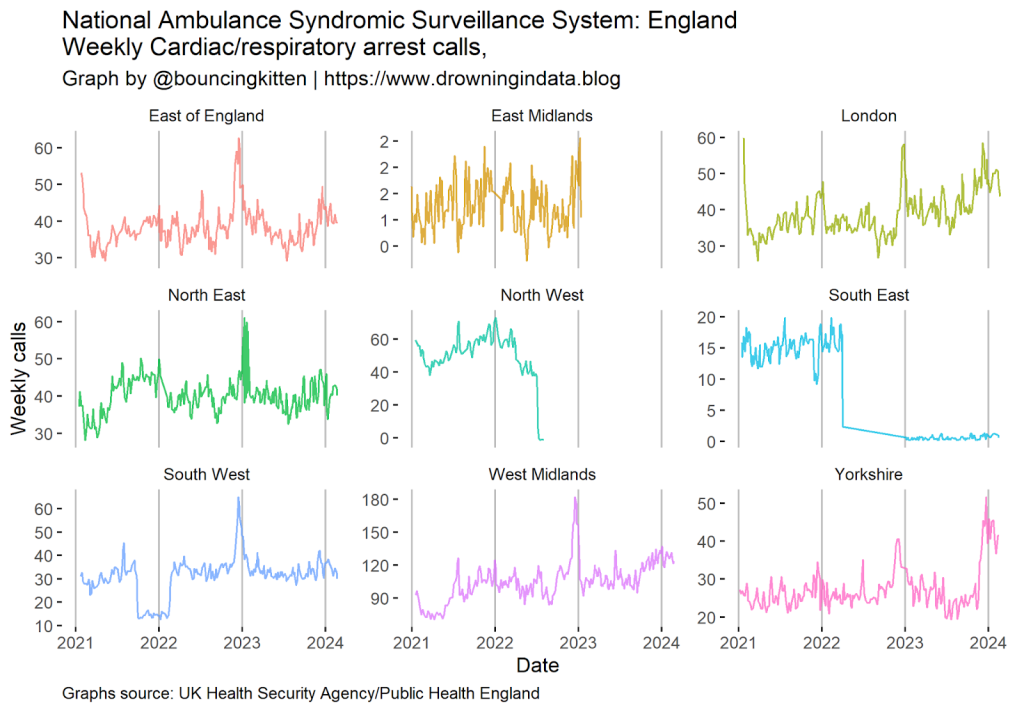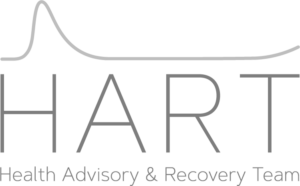
Higher in ’22 and ’23 than 2020
All HART articles also on Substack. Please consider a PAID SUBSCRIPTION so we can continue our work. Comments are open so you can join in the conversation.
Weekly cardiac arrest calls were higher in 2022 and 2023 than 2020. Looking at the trends in 2024 would be interesting – if only it were possible.
The National Ambulance Syndromic Surveillance System records and presents data from England’s ten ambulance trusts. They record how many weekly calls were made for several different syndromes. Cardiac and respiratory arrest calls are recorded for each trust and graphed together in the weekly bulletins. These are available from end 2019 to the present.
Each trust is required to record different syndrome groups for its calls and the NASSS bulletin presents them together. Reviewing the data for each trust shows how the trends for calls have changed over the last four years.

First thing to notice is there are nine trusts in our most recent analysis (up to week 8 2024) with data available. North West and East Midlands ambulance services have stopped reporting data due to unspecified technical issues. The South East Ambulance Service has also ceased to report consistently. This means that any national figures from around mid-2022 on do not include full data from three ambulance services, and cannot be compared to data from 2019-2021.
The format of the NASSS bulletins changed at the end of 2020. Previously, national figures were presented with no breakdown into individual ambulance services. From 2021 on, graphs showing national and regional figures are presented. These aren’t available in a raw numerical format on the UKHSA website, so data was read from the graphs in the PDF bulletins using WebPlotDigitizer.
Looking at the available data, six ambulance services (East of England, London, North East, South West, West Midlands and Yorkshire) show a large spike in calls at the end of 2022 and start of 2023. London and Yorkshire show a similar increase at the end of 2023 and start of 2024 which matches or exceeds the 2022/2023 spike. The trend for London shows a concerning increase right through 2023.
The regional data show that cardiac calls are increasing and showing increasing seasonal spikes for several trusts. However, there’s incomplete data, and currently we can’t compare national trends for 2023/2024 with previous years because of the reporting issues across different trusts.
Submitting a Freedom of Information (FOI) request often reveals data that is otherwise unavailable on UK Government websites. An FOI request by Clare Craig was sadly incomplete and in an incompatible format to the NASSS bulletins. The FOI response divides up the data into ten different regions to the NASSS bulletin, making direct comparisons impossible. The response also failed to include data from four of those regions.
The rate of calls seems to be increasing, but the reporting issues mean that we can’t see how much of a problem this is across England. The NASSS FOI doesn’t help as its formatting is different. Hopefully, someone is counting these figures and taking action to understand how trends in cardiac emergencies have changed in the post-COVID era.
